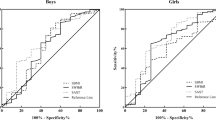Abstract
Objective: The aim of this study is to determine the prevalence of overweight and obesity among Bahraini adolescents using three different sets of criteria/standards.
Design: Cross-sectional prevalence study.
Setting: Intermediate and secondary schools in Bahrain.
Subjects: The study included a population-representative sample of 506 Bahraini students (249 males and 257 females) between 12 and 17 y of age. The sample was selected using multistage stratified random sampling technique.
Measurment: Anthropometric measurements including weight, height and triceps and subscapular skinfolds were taken on the adolescents. Age was verified against school records. To minimize inter-observer error, weight and height were taken by one person while skinfold was taken by two trained persons (one for each sex).
Results: The overall prevalence of obesity among Bahraini boys and girls was high, especially in girls. Obesity was highest (21% in males and 35% in females) when the WHO recommended criteria of BMI for age and skinfolds for age percentiles were applied and lowest (15% in boys and 18% in girls) when the age and sex specific BMI cut-off values of Cole et al were used. Compared with those of WHO criteria, estimates of overweight and obesity prevalence obtained with Must et al and Cole et al were generally close.
Conclusions: Our data revealed a much higher prevalence rate of obesity in the Bahraini adolescent population than was previously reported, especially among girls. The BMI reference values of Must et al and that of Cole et al gave relatively similar estimates and appear to be more practical for use in surveys aimed at estimating the prevalence of overweight and obesity among adolescents than the WHO recommended composite criteria.
Sponsorship: Ministry of Health, Bahrain.
This is a preview of subscription content, access via your institution
Access options
Subscribe to this journal
Receive 12 print issues and online access
$259.00 per year
only $21.58 per issue
Buy this article
- Purchase on Springer Link
- Instant access to full article PDF
Prices may be subject to local taxes which are calculated during checkout
Similar content being viewed by others
References
Al-Nuaim, AR, Bamgboye, EA & Al-Herbish, A (1996). The pattern of growth in Saudi Arabian male school children. Int. J. Obes. Relat. Metab. Disord., 20, 1000–1005.
Amine, EK (1980). Bahrain Nutrition Status Survey, Abu-Dubi: UNICEF, Gulf Area Office
Bini, V, Celi, F, Berioli, MG, Bacosi, ML, Stella, P, Giglio, P, TosTi, L & Falorni, A (2000). Body mass index in children and adolescents according to age and pubertal stage. Eur. J. Clin. Nutr., 54, 214–218.
Blair, D & Gregory, WB (1985). The Nutrition Status of Bahraini Girls aged 7–18 years, Bahrain: Bahrain Sport Institute
Cole, TJ, Bellizzi, MC & Flegal, KM (2000). Establishing standard definition for child overweight and obesity worldwide: International survey. Br. Med. J., 320, 1240–1243.
Daniels, SR, Khoury, PR & Morrison, JA (1997). The utility of body mass index as a measure of body fatness in children and adolescents: differences by race and gender. Pediatric, 99, 804–807.
Eid, N, Al-Hotti, S, Bourishly, N & Khalafawi, M (1986). Nutritional anthropometry of school children in Kuwait. Nutr. Report. Int., 33, 253–260.
Fidanza, F (1991). Nutritional Assessment: a Manual for Population Studies, ed. F Fidanza London: Chapman & Hall
Flegal, KM, Ogden, CL, Wei, R, Kuczmarski, RL & Johnson, CL (2001). Prevalence of overweight in US children: comparison of US growth charts from the Centers for Disease Control and Prevention with other reference values for body mass index. Am. J. Clin. Nutr., 73, 1086–1093.
Himes, JH (1989). Reliability of anthropometric methods and replicate measurements. Am. J. Anthropol., 79, 77–80.
Himes, JH & Dietz, WH (1994). Guidelines for overweight in adolescent preventative services: recommendations from and expert committee. Am. J. Clin. Nutr., 59, 307–316.
Ministry of Health (2000). Health Statistics, Bahrain, Manama
Musaiger, AO, Matter, AM, Alekri, SA & Mahdi, A (1993). Obesity among secondary school students in Bahrain. Nutr. Health, 9, 25–32.
Musaiger, AO, Al-Ansari, M & Al-Mannai, M (2000). Anthropometry of adolescent girls in Bahrain, including body fat distribution. Ann. Hum. Biol., 27, 507–515.
Must, A & Strauss, RS (1999). Risks and consequences of childhood and adolescent obesity. Int. J. Obes. Relat. Metab. Disord., 23, (Suppl 2) S2–S11.
Must, A, Dallal, GE & Dietz, WH (1991). Reference data for obesity: 85th and 95th percentile body mass index (wt/ht2) and triceps skinfold thickness. Am. J. Clin. Nutr., 53, 839–846.
Rolland-Cachera, MF, Deheger, M & Bellisle, F (2001). Definition actuelle et evolution de la frequence de l'obesite' chez l'enfant. Cah. Nutr. Diet., 36, 108–112.
WHO (1995). Physical status: the use and interpretation of anthropometry, WHO Technical Report Series no. 854, p271 Geneva: World Health Organization
Author information
Authors and Affiliations
Contributions
Guarantor: AM Al-Sendi
Contributors: AM Al-Sendi, P Shetty, AO Musiager
Corresponding author
Additional information
College of Health Science, Ministry of Health, Bahrain
Rights and permissions
About this article
Cite this article
Al-Sendi, A., Shetty, P. & Musaiger, A. Prevalence of overweight and obesity among Bahraini adolescents: a comparison between three different sets of criteria. Eur J Clin Nutr 57, 471–474 (2003). https://doi.org/10.1038/sj.ejcn.1601560
Received:
Revised:
Accepted:
Published:
Issue Date:
DOI: https://doi.org/10.1038/sj.ejcn.1601560
Keywords
This article is cited by
-
Overweight and obesity prevalence among Cree youth of Eeyou Istchee according to three body mass index classification systems
BMC Pediatrics (2017)
-
Is high waist circumference and body weight associated with high blood pressure in Iranian primary school children?
Eating and Weight Disorders - Studies on Anorexia, Bulimia and Obesity (2016)
-
Comparison of three criteria for overweight and obesity classification in brazilian adolescents
Nutrition Journal (2013)
-
Variability of thinness and its relation to cardio-metabolic risk factors using four body mass index references in school-children from Delhi, India
Indian Pediatrics (2013)
-
Obesity prevalence estimates in a Canadian regional population of preschool children using variant growth references
BMC Pediatrics (2011)


